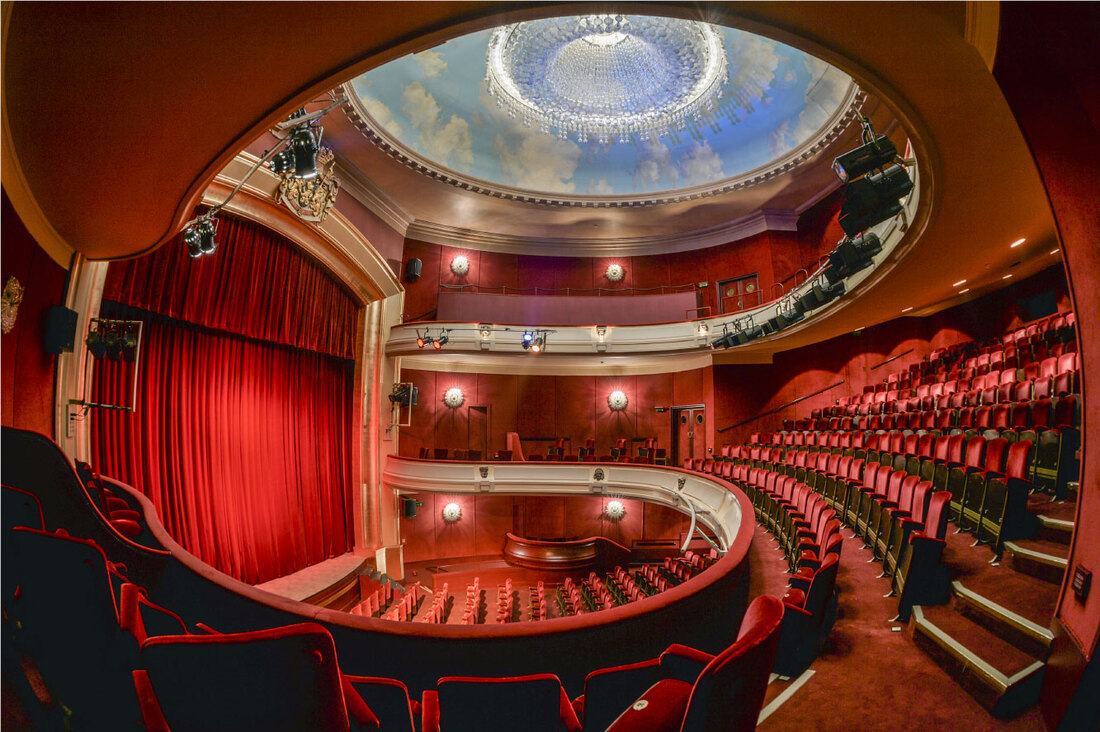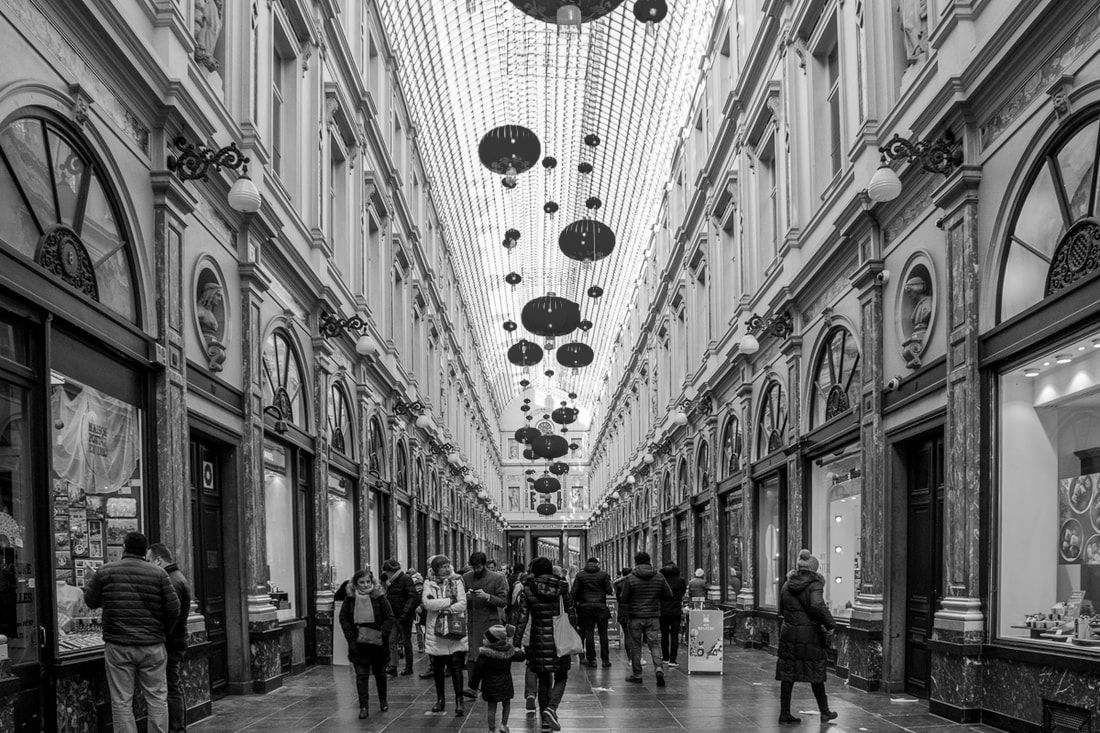MIDSUMMER MOZARTIADE
THÉÂTRE ROYAL DES GALERIES
The 'Théâtre des Galeries', designed by Cluysenaer himself, was inaugurated on 7 June 1847, a few weeks before the official inauguration of the entire passage. It was inspired by the success of the 'Théâtre du Palais-Royal' in Paris, which was also located in the middle of a shopping arcade, of which it was one of the main attractions.
The new theatre, initially called 'L'opéra-comique', was conceived as an annex to the Monnaie Opera to allay justified fears of unwelcome competition. Indeed, with the opening of this neighbouring theatre, the 'Théâtre de la Monnaie' was to lose its monopoly on the performance of French or Italian lyric repertoire in the capital. Italian troupes in particular came to Brussels on a seasonal basis, sometimes playing in the 'Théâtre des Galeries', sometimes in other houses.
In the early 20th century, the theatre with its decidedly avant-garde programme was the Brussels stage for the 'Ballets Russes'. In the interwar period, it mainly hosted French stars, supported by hastily selected Belgian actors as stooges. Later, it was used for a time by the National Theatre. In 1951, it was demolished and rebuilt by the architect Paul Bonduelle and decorated by Jasinski.
Although the hall retained its red and gold velvet look, it was now larger and featured two large balconies facing the stage, instead of the previous four narrow side galleries. All this greatly improved the comfort of the audience. As part of this renovation, René Magritte painted one of his signature 'clouds' frescoes on the ceiling. Once these major works had been completed, the new 'Compagnie des Galeries' launched its programming.
Thanks to director Jean-Pierre Rey's fresh ideas and organisational talents, a new breeze blew through the capital's theatre scene. His company, which performed continuously at the 'Théâtre des Galeries' as well as at the 'Théâtre Molière' near the 'Porte de Namur', offered a well-chosen, varied and accessible repertoire. That made the 'Compagnie des Galeries' a resounding success.
One of the showpieces of the 'Compagnie des Galeries' (besides its celebrated end-of-year revues launched in 1954) was undoubtedly 'Le Mariage de Mademoiselle Beulemans'. This Brussels comedy, written in 1910 by Fernand Wicheler and Frantz Fonson, would be revived countless times. The popular success of the play was huge, both in Belgium and abroad.
Today, the 'Théâtre Royal des Galeries', directed by David Michels since 1998, continues to strive to offer programming for all audiences. Its bold and communicative productions aim to renew the view of reality, resulting in the great diversity of styles that is the theatre’s trademark.
Here one encounters authors as diverse as Feydeau, Molière, Shakespeare, Chekhov, Pirandello, Ray Cooney, Neil Simon, Oscar Wilde, Tennessee Williams, Alan Ayckbourn, Agatha Christie, Eric-Emmanuel Schmitt, Peter Schaffer, Eric Assous, Marie-Paule Kumps, David Mamet, Shelagh Stephenson... and Mozart.
www.trg.be
The new theatre, initially called 'L'opéra-comique', was conceived as an annex to the Monnaie Opera to allay justified fears of unwelcome competition. Indeed, with the opening of this neighbouring theatre, the 'Théâtre de la Monnaie' was to lose its monopoly on the performance of French or Italian lyric repertoire in the capital. Italian troupes in particular came to Brussels on a seasonal basis, sometimes playing in the 'Théâtre des Galeries', sometimes in other houses.
In the early 20th century, the theatre with its decidedly avant-garde programme was the Brussels stage for the 'Ballets Russes'. In the interwar period, it mainly hosted French stars, supported by hastily selected Belgian actors as stooges. Later, it was used for a time by the National Theatre. In 1951, it was demolished and rebuilt by the architect Paul Bonduelle and decorated by Jasinski.
Although the hall retained its red and gold velvet look, it was now larger and featured two large balconies facing the stage, instead of the previous four narrow side galleries. All this greatly improved the comfort of the audience. As part of this renovation, René Magritte painted one of his signature 'clouds' frescoes on the ceiling. Once these major works had been completed, the new 'Compagnie des Galeries' launched its programming.
Thanks to director Jean-Pierre Rey's fresh ideas and organisational talents, a new breeze blew through the capital's theatre scene. His company, which performed continuously at the 'Théâtre des Galeries' as well as at the 'Théâtre Molière' near the 'Porte de Namur', offered a well-chosen, varied and accessible repertoire. That made the 'Compagnie des Galeries' a resounding success.
One of the showpieces of the 'Compagnie des Galeries' (besides its celebrated end-of-year revues launched in 1954) was undoubtedly 'Le Mariage de Mademoiselle Beulemans'. This Brussels comedy, written in 1910 by Fernand Wicheler and Frantz Fonson, would be revived countless times. The popular success of the play was huge, both in Belgium and abroad.
Today, the 'Théâtre Royal des Galeries', directed by David Michels since 1998, continues to strive to offer programming for all audiences. Its bold and communicative productions aim to renew the view of reality, resulting in the great diversity of styles that is the theatre’s trademark.
Here one encounters authors as diverse as Feydeau, Molière, Shakespeare, Chekhov, Pirandello, Ray Cooney, Neil Simon, Oscar Wilde, Tennessee Williams, Alan Ayckbourn, Agatha Christie, Eric-Emmanuel Schmitt, Peter Schaffer, Eric Assous, Marie-Paule Kumps, David Mamet, Shelagh Stephenson... and Mozart.
www.trg.be
GALERIES ROYALES SAINT-HUBERT
The gallery project, initiated around 1837 by the young Dutch architect Jean-Pierre Cluysenaer, aimed to redevelop a dilapidated working-class neighbourhood by building a luxurious complex of flats, shops, cultural spaces and promenade areas. Construction finally began in 1846 and the official inauguration took place on 20 June 1847 in the presence of King Leopold I.
The success of this new passage was immediate. From the moment it opened, it enjoyed great popularity, which only increased with the installation of specialised luxury boutiques. The ‘outdoor terraces’ of these cafés, pastry shops and ice cream parlours attracted an elite public eager to forget the vagaries of the Belgian climate for a few hours.
Ahead of its time
Brussels thus gained a monumental ‘covered street’ and took its place among the great European cities such as Paris and London, even ahead of Milan, Moscow and Berlin. This Florentine Renaissance-style arcade, long called the 'umbrella of Brussels' because of its end-to-end glass roof, is the finest testimony to the city's commercial boom prior to the advent of department stores. The ingenious ‘verrière’, supported by a series of self-supporting metal arches, features 'fish scale' panes that provide excellent ventilation and prevent condensation.
The new place to be
All the celebrities of the day were seen there. The 'Taverne du Passage', known as the 'Café des Arts' until 1892, quickly became a meeting place for the painters and writers of the day. The colony of French exiles, such as Victor Hugo, Alexandre Dumas, Edgar Quinet and others, gathered there. It was not uncommon to come across Charles Baudelaire there in his day. And Paul Verlaine bought from a shop in the Queen's Gallery the pistol he used to shoot his lover Arthur Rimbaud in the hand.
Even if the Neuhaus family had been selling cough drops, marshmallows and stomach pastilles in their small confectionery shop at Queen's Gallery 23 since 1857, it was Jean Neuhaus III who invented the 'praline' one fine morning in 1912. Some time later, his wife, tired of serving chocolates in a paper cone, came up with the idea of arranging them carefully in a small cardboard box called a ‘ballotin’.
The success of this new passage was immediate. From the moment it opened, it enjoyed great popularity, which only increased with the installation of specialised luxury boutiques. The ‘outdoor terraces’ of these cafés, pastry shops and ice cream parlours attracted an elite public eager to forget the vagaries of the Belgian climate for a few hours.
Ahead of its time
Brussels thus gained a monumental ‘covered street’ and took its place among the great European cities such as Paris and London, even ahead of Milan, Moscow and Berlin. This Florentine Renaissance-style arcade, long called the 'umbrella of Brussels' because of its end-to-end glass roof, is the finest testimony to the city's commercial boom prior to the advent of department stores. The ingenious ‘verrière’, supported by a series of self-supporting metal arches, features 'fish scale' panes that provide excellent ventilation and prevent condensation.
The new place to be
All the celebrities of the day were seen there. The 'Taverne du Passage', known as the 'Café des Arts' until 1892, quickly became a meeting place for the painters and writers of the day. The colony of French exiles, such as Victor Hugo, Alexandre Dumas, Edgar Quinet and others, gathered there. It was not uncommon to come across Charles Baudelaire there in his day. And Paul Verlaine bought from a shop in the Queen's Gallery the pistol he used to shoot his lover Arthur Rimbaud in the hand.
Even if the Neuhaus family had been selling cough drops, marshmallows and stomach pastilles in their small confectionery shop at Queen's Gallery 23 since 1857, it was Jean Neuhaus III who invented the 'praline' one fine morning in 1912. Some time later, his wife, tired of serving chocolates in a paper cone, came up with the idea of arranging them carefully in a small cardboard box called a ‘ballotin’.
Ready for the future
The owners, descendants of the Galeries’ founders, have continued to manage the buildings, maintaining the urban mix desired by Cluysenaer. In 1939, the 'Cinéma des Galeries' was built and in 1950, the 'Théâtre Royal des Galeries' was transformed with the collaboration of René Magritte, who decorated the ceiling. The buildings were listed by the Brussels-Capital Region in 1986.
Numerous renovations have been carried out since 1995: the facades, the glass roof, the 'Théâtre du Vaudeville', the 'Théâtre Royal des Galeries', flats, offices and a newly opened hotel, the 'Hôtel des Galeries'... Today, with its 6 million visitors a year, the ‘Galeries Royales Saint-Hubert’ remains one of the most popular places in Brussels.
www.grsh.be
The owners, descendants of the Galeries’ founders, have continued to manage the buildings, maintaining the urban mix desired by Cluysenaer. In 1939, the 'Cinéma des Galeries' was built and in 1950, the 'Théâtre Royal des Galeries' was transformed with the collaboration of René Magritte, who decorated the ceiling. The buildings were listed by the Brussels-Capital Region in 1986.
Numerous renovations have been carried out since 1995: the facades, the glass roof, the 'Théâtre du Vaudeville', the 'Théâtre Royal des Galeries', flats, offices and a newly opened hotel, the 'Hôtel des Galeries'... Today, with its 6 million visitors a year, the ‘Galeries Royales Saint-Hubert’ remains one of the most popular places in Brussels.
www.grsh.be


